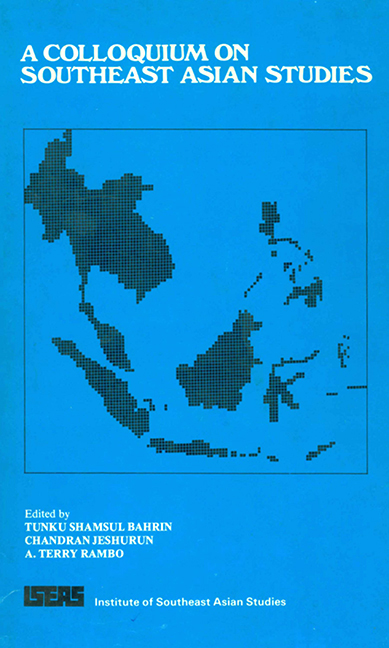Book contents
- Frontmatter
- Contents
- Foreword
- Preface
- Acknowledgements
- Introduction
- Contributors
- PART I TEACHING AND RESEARCH
- THE CONCEPTUAL THEORIES
- 1 Southeast Asian Studies: Problems and Potentialities — East and West
- 2 Southeast Asian Studies: Some Unresolved Problems
- 3 The Challenge of Diversity: Southeast Asian Studies and the Development of Social Science
- THE EXTRAREGIONAL EXPERIENCE
- THE REGIONAL PERSPECTIVE
- THE PROBLEMS OF TEACHING AND RESEARCH
- PART II ENVIRONMENT AND DEVELOPMENT
2 - Southeast Asian Studies: Some Unresolved Problems
from THE CONCEPTUAL THEORIES
Published online by Cambridge University Press: 21 October 2015
- Frontmatter
- Contents
- Foreword
- Preface
- Acknowledgements
- Introduction
- Contributors
- PART I TEACHING AND RESEARCH
- THE CONCEPTUAL THEORIES
- 1 Southeast Asian Studies: Problems and Potentialities — East and West
- 2 Southeast Asian Studies: Some Unresolved Problems
- 3 The Challenge of Diversity: Southeast Asian Studies and the Development of Social Science
- THE EXTRAREGIONAL EXPERIENCE
- THE REGIONAL PERSPECTIVE
- THE PROBLEMS OF TEACHING AND RESEARCH
- PART II ENVIRONMENT AND DEVELOPMENT
Summary
Today we take the term “Southeast Asia” for granted and at times it is difficult for us to imagine that it is only since World War II that the term has come into general usage for the countries stretching from Burma to Vietnam and from the Philippines to Indonesia. Prior to this appellations such as Further India, East Indies, and Far Eastern Tropics were the common terms for this region of ours. Changing nomenclatures notwithstanding, Southeast Asia has continued to be an area of considerable vitality and significance to Asia as a whole and the wider world. Moreover, the Southeast Asian lands and societies are bound by so many distinctive and continuous strands and separated by so many cleavages that expressions like “unity within diversity” or “diversity within unity” have become almost synonymous with the region. Thus, we have a Southeast Asia that is ancient yet modern; sufficiently urbanized yet essentially rustic; forward looking yet traditional; politically independent yet seemingly dependent; geographically fragmented yet focal; and, finally, only partly developed yet, in addition to substantial quantities of pineapples, timber, oil, and gas, already a producer of more than 90% of the world's rubber, 75% of its copra, and 60% of its palm oil and tin. In short, Southeast Asia is a complex but extremely exciting region with a tremendous developmental potential. After all, it is larger in area than, say, India and is already the home of more than 300 million people who are expected to increase to some 500 million before the end of this century. And if we are to believe the predictions and projections of economic experts, then Southeast Asia will be one of the fastest growing regions of the world in the 1980s and 1990s. Yet despite such exciting prospects and a cultural heritage of great diversity and ancient lineage, how much do we Southeast Asians really know about our individual countries and those of our immediate fellow neighbours?
- Type
- Chapter
- Information
- A Colloquium on Southeast Asian Studies , pp. 15 - 27Publisher: ISEAS–Yusof Ishak InstitutePrint publication year: 1981



